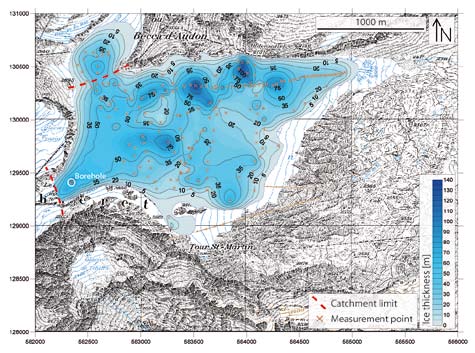Geometry and drainage of a retreating glacier overlying and recharging a karst aquifer, Tsanfleuron-Sanetsch, Swiss Alps
DOI:
https://doi.org/10.3986/ac.v39i2.100Povzetek
Alpine glaciers store large amounts of freshwater contributing to groundwater recharge during warmer periods, but the interactions between glaciers and aquifers have rarely been investigated in detail. The Tsanfleuron-Sanetscharea, Switzerland, is an ideal test site to study glacier-aquifer interactions. It consists of a rapidly retreating glacier (2.8 km2) overlying a karst aquifer drained by a spring (mean discharge 600–700 L/s) used for drinking water supply and irrigation. The geometry and structure of the glacier were assessed by means of geophysical surveys, using radiomagnetotellurics (RMT). The estimated ice volume is 1.0 x 108 m3 (0.92 x 108 m3 water equivalent), but the glacier currently loses 1.5 m ice thickness per year. Field observations, flow measurements and tracer tests allowed characterisation of glacier drainage and aquifer recharge. Three recharge pathways have been identified: 1) The main glacial stream sinks into the aquifer via swallow holes 3 km downstream of the glacier mouth; 2) Numerous small meltwater streams sink underground shortly below the glacier front; 3) Subglacial meltwaters and supraglacial streams sink into the glacier via moulins and contribute to aquifer recharge throughfractures and swallow holes underneaththe glacier. Recharge and spring discharge display strong diurnal and seasonal variability, witha general high-flow period during snow and glacier melt from spring to autumn. Preliminary predictions of the future availability of spring water after disappearance of the glacier suggest that the discharge may decrease by 20–30%. Nearly all of this loss will occur in summer and autumn, presumably resulting in temporary water shortage.Prenosi
Podatki o prenosih še niso na voljo.

Prenosi
Objavljeno
2010-06-01
Kako citirati
Gremaud, V., & Goldscheider, N. (2010). Geometry and drainage of a retreating glacier overlying and recharging a karst aquifer, Tsanfleuron-Sanetsch, Swiss Alps. Acta Carsologica, 39(2). https://doi.org/10.3986/ac.v39i2.100
Številka
Rubrike
Original papers
Licenca
Avtorji jamčijo, da je delo njihova avtorska stvaritev, da v njem niso kršene avtorske pravice tretjih oseb ali kake druge pravice. V primeru zahtevkov tretjih oseb se avtorji zavezujejo, da bodo varovali interese založnika ter da bodo povrnili morebitno škodo.
Podrobneje v rubriki: Prispevki




